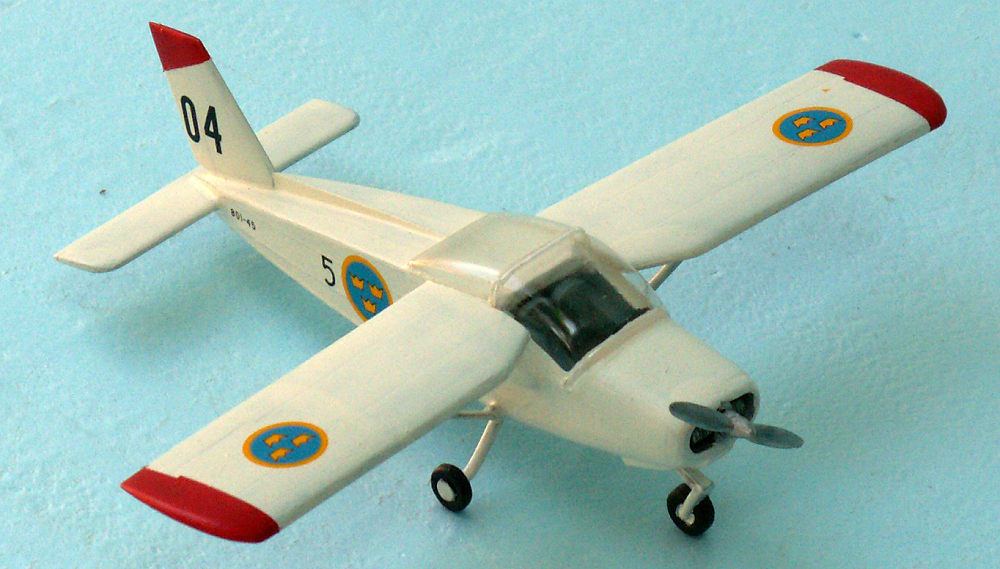
Flugzeug 1/72 Bolkow Junior (MFI-9)
| KIT #: | 1002 |
| PRICE: | $17 USD on sale |
| DECALS: | Four options |
| REVIEWER: | Torben Plesberg |
| NOTES: | Short run kit |

| HISTORY |
In the fifties, the Swedish aircraft designer Björn Andreasson was working for Convair in California. In his spare time, he designed and built a light 2 seater sporting plane named BA-7, his seventh project presumably. It was powered by an air cooled Continental 75 HP engine with a 2 bladed variable-pitch propeller. This shoulder wing design was flown for the first time 10-10-1958. The shoulder wings were swept forward for the sake of better visibility from the cockpit. The fin and rudder was designed like that of a Turbo Porter. It turned out, that this arrangement could cause rudder blocking. This problem was solved by designing a new swept fin and rudder.
I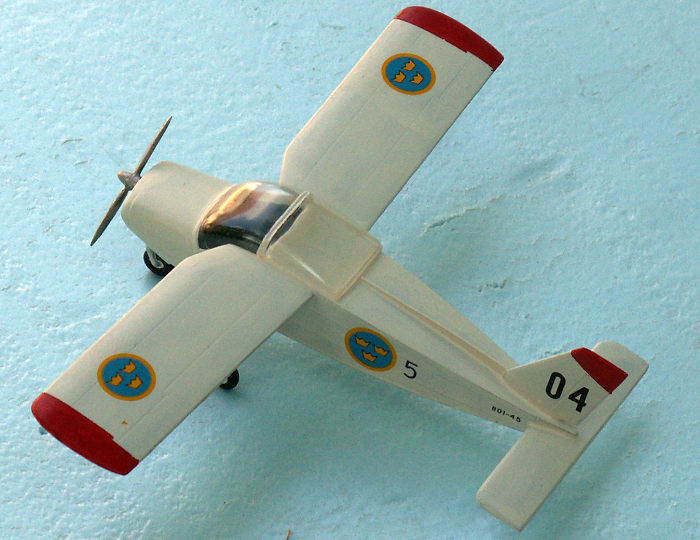 n
1960 Björn Andreasson moved back to Sweden and got a job at Malmö Flygindustri.
He designed an improved version of his American BA-7, and this aircraft went
into production as the MFI Junior. The improvements included a larger cockpit
with a “bulb” in each side, for better room for hand movements, and a
Continental 100 HP engine. This aircraft had the same performance as other
aircraft with a 150 HP engine, and it was therefore very economical to fly.
n
1960 Björn Andreasson moved back to Sweden and got a job at Malmö Flygindustri.
He designed an improved version of his American BA-7, and this aircraft went
into production as the MFI Junior. The improvements included a larger cockpit
with a “bulb” in each side, for better room for hand movements, and a
Continental 100 HP engine. This aircraft had the same performance as other
aircraft with a 150 HP engine, and it was therefore very economical to fly.
At that time, the Swedish Air Force – Flygvapnet – was considering replacement aircraft for the Fpl 51 Super Cub artillery observation and liaison aircraft and the SK 50 SAAB Safir elementary trainer. Flygvapnet leased in 1964 two Juniors called Militrainers for testing with rocket shooting, and in 1966 ten Militrainers were leased for two years for testing with the F 5 (Krigsflygskolan) under the designation Fpl 801. However, none of the tests resulted in orders for MFI to produce aircraft for Flygvapnet. The Scottish Aviation Bulldog was selected as the replacement plane for the SK 50 Safir. The Super Cub, Flp 51 was replaced by the German Dornier Do 27, Flp 53. It possessed similar STOL characteristics as the Super Cub.
The MFI-9 was developed further and called MFI-15 Safari. Later this project was taken over by SAAB, and the designation changed to SAAB MFI-17 Supporter. The engine was a continental of 210 HP, and the elevator was moved to the fin for better coping with landings on rough fields. The Royal Danish Air Force selected the Supporter as new elementary trainer as a replacement aircraft for the DHC-1 Chipmunk. Flyvevåbnet bought in 1974 32 planes, and most of these are still serving as elementary trainers with Flyveskolen at Karup AFB. The year 2013 saw the first aircraft to log 10.000 flying hours!
Björn Andreassons
design was indeed a very successful one: The Royal Norwegian Air Force bought
the MFI-15 Safari as elementary trainer (16 aircraft), and the Pakistan Air
Force bought the SAAB MFI-17 S upporter
(+ 200 aircraft). All together, the Safari/Supporter was produced in 462
examples.
upporter
(+ 200 aircraft). All together, the Safari/Supporter was produced in 462
examples.
The history of the MFI-9 would not be complete without mentioning count Carl Gustaf von Rosen and his air war against the Nigerian Air Force in 1969:
Count von Rosen was born in 1909. His interest for flying, was probably aroused by the famous WWI fighter ace and last commander of the Richthofen Geschwader, Herman Goering, who happened to be his uncle. Young von Rosen made a career as a pilot with the KLM, the renowned Dutch airline. During WWII, he flew bombing missions for the Finns against the Russians. Later he flew Dutch Government papers to England with a KLM DC-3. Being in England, he applied for service with the RAF. However, he was turned down because of his family relation to Herman Goering, the commander in chief of the Luftwaffe. In the USA another relative of Goering got his wings as a bomber pilot to fight against Germany. Interesting difference in the British and American way of thinking!
In 1969 von Rosen was disgusted by the attacks of the Nigerian Air Force against unarmed civilians in Biafra. He decided to something about it, and figured out that a handful of MFI Militrainers armed with SNEB 68 mm rockets might be very effective against the Nigerian Air Force. He managed to buy five of the planes, which had been tested by Flygvapnet, had the planes armed in France and transported to Biafra, where the planes were assembled and painted in a camouflage pattern. Von Rosen and four other pilots made strikes against airfields of the Nigerian Air Force, and they managed to destroy 7 MiG 17 fighters, and 3 Il 28 bombers on the ground! The MiniCOIN aircraft were very effective, indeed.
MFI built all together 68 MFI-9 aircraft. In Germany Bölkow Apparatebau GmbH, Laupheim, Bavaria built 210 Bölkow Bö 208 Junior. Many of these planes are still flying in Scandinavia, England and Germany.
| THE KIT |
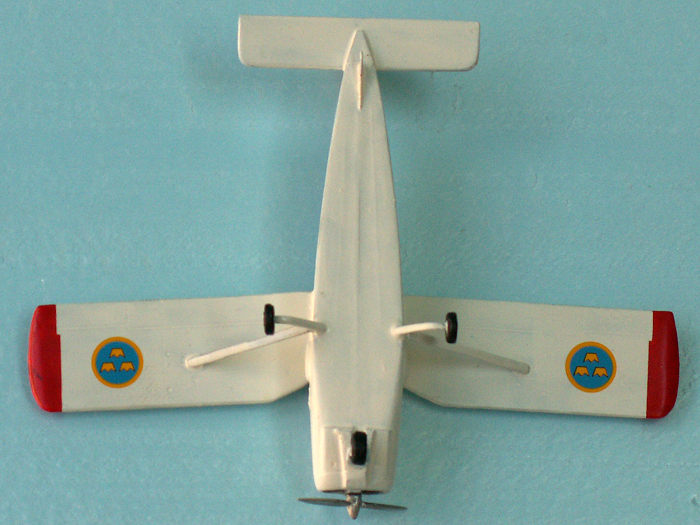 The kit comes
in a small box with a photo of a Bö 208 on the lid. The instructions is a single
folded A4 sheet with the story of the MFI Junior and the Bö 208 in German only.
A single sketch shows how to put the 19 parts together. There are three drawings
showing the painting and decaling of the options of the kit. The decal sheet is
unusable, because the printing is out of alignment with the carrier film! There
is a single sprue in a medium grey styrene, a small bag containing the white
metal parts (propeller, undercarriage, wing struts and SNEB rocket pods) and a
vacuum-formed canopy. Besides there is a small piece of 0.8 mm plastic card for
the fin fillet and the tail bump. The quality of the plastic parts is different:
the wings, tail planes and fin are good, the fuselage halves are very clumsy,
and the engine is hopeless – hardly to be recognized as two cylinders of a boxer
engine. The white metal parts are roughly cast, and need some trimming. These
parts are rather soft, and they bend too easily! The canopy is OK, however, you
have only one try to cut it perfectly in shape for the cockpit opening.
The kit comes
in a small box with a photo of a Bö 208 on the lid. The instructions is a single
folded A4 sheet with the story of the MFI Junior and the Bö 208 in German only.
A single sketch shows how to put the 19 parts together. There are three drawings
showing the painting and decaling of the options of the kit. The decal sheet is
unusable, because the printing is out of alignment with the carrier film! There
is a single sprue in a medium grey styrene, a small bag containing the white
metal parts (propeller, undercarriage, wing struts and SNEB rocket pods) and a
vacuum-formed canopy. Besides there is a small piece of 0.8 mm plastic card for
the fin fillet and the tail bump. The quality of the plastic parts is different:
the wings, tail planes and fin are good, the fuselage halves are very clumsy,
and the engine is hopeless – hardly to be recognized as two cylinders of a boxer
engine. The white metal parts are roughly cast, and need some trimming. These
parts are rather soft, and they bend too easily! The canopy is OK, however, you
have only one try to cut it perfectly in shape for the cockpit opening.
| CONSTRUCTION |
Construction: The
construction is very simple with only 19 parts to put together. The fuselage
halves are very thick (+2 mm). The fuselage sides of the cockpit must be milled
to a thickness slightly less than one
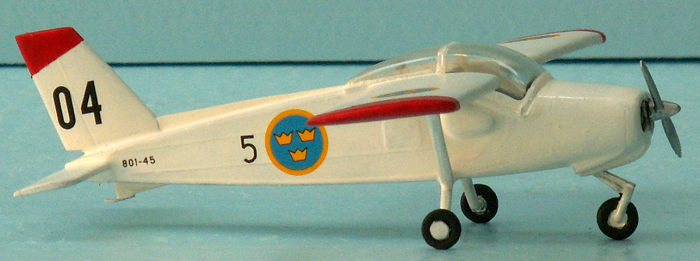 mm. The
engine part is hopeless! I solved this problem with a small piece of M 3 thread
and a nut in the middle as basis for the propeller. You must drill holes for the
undercarriage legs – not too close to the edge of the fuselage. The plastic card
piece for making the fin fillet and tail bumper is too thick. I used 0.37 mm
plastic card for these items. The two seats are rather massive. The important
thing is, if there is room enough for them to be glued in place.
mm. The
engine part is hopeless! I solved this problem with a small piece of M 3 thread
and a nut in the middle as basis for the propeller. You must drill holes for the
undercarriage legs – not too close to the edge of the fuselage. The plastic card
piece for making the fin fillet and tail bumper is too thick. I used 0.37 mm
plastic card for these items. The two seats are rather massive. The important
thing is, if there is room enough for them to be glued in place.
With the fuselage assembled, it was necessary to put as much lead as possible into the nose and on the floor in front of the seats. The model is a born tail-sitter. The instructions suggests even to make the rear fuselage thinner to save some weight – to avoid tail sitting! There are two alternative nose gears: a straight one and an angled one. I chose the latter.
| COLORS & MARKINGS |
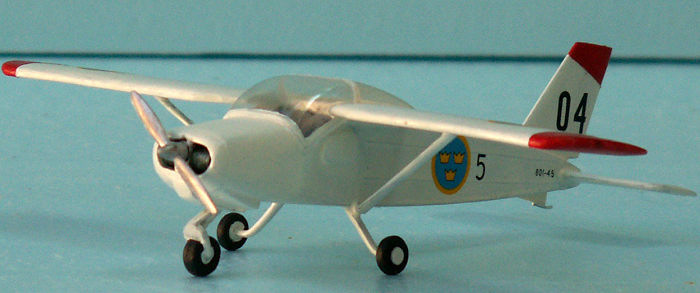 I
chose to make one of the ten Militrainers, which were evaluated by Flygvapnet
1966-68. There was no suggestions how to paint the interior of the cockpit. I
painted the instrument panel black, the inner sides olive green, and the seats
leather. The color scheme of Flp 801 is off white all over with red wingtips and
the top of the fin. The kit was bought in a Swedish model shop, and there was an
extra decal sheet with markings for a Swedish Militrainer in the box. This decal
sheet comprised six national markings, a black 5 for the F 5 wing, a small
Flygvapen serial number also in black, and an individual marking on the fin: 04.
The entire model got a layer of Satin Cote for protection of the decals and
providing a nice finish for the aircraft.
I
chose to make one of the ten Militrainers, which were evaluated by Flygvapnet
1966-68. There was no suggestions how to paint the interior of the cockpit. I
painted the instrument panel black, the inner sides olive green, and the seats
leather. The color scheme of Flp 801 is off white all over with red wingtips and
the top of the fin. The kit was bought in a Swedish model shop, and there was an
extra decal sheet with markings for a Swedish Militrainer in the box. This decal
sheet comprised six national markings, a black 5 for the F 5 wing, a small
Flygvapen serial number also in black, and an individual marking on the fin: 04.
The entire model got a layer of Satin Cote for protection of the decals and
providing a nice finish for the aircraft.
| CONCLUSIONS |
It was a challenge to build this very small aircraft from a rather poor kit. With some effort, it was possible to attain a reasonable model. The kit is not recommendable in general, especially not for beginners. If you have a special interest for this remarkable type of aircraft, well, it is the only game in town!
| REFERENCES |
Wikipedia articles: “Malmö MFI-9” and “Carl Gustaf von Rosen”.
Björn Karlström: Flygplansritningar 6 – Swedish Military Helicopters, Gliders, Test & Army Aircraft. Page 32-35 MFI-9B, 1/72 and 1/50 scale. Publisher: Allt om Hobby. ISBN 91-85496-39-1
My own photos of the MFI-9, especially the SE-202, one of the two test planes, Flygvapnet 1964.
16 October 2014
Copyright ModelingMadness.com
Thanks to www.dragonmodelsusa.com for the preview kit. You can find this kit at your favorite hobby shop or on-line retailer.
If you would like your product reviewed fairly and fairly quickly, please contact the editor or see other details in the Note to Contributors.
Back to the Main Page Back to the Previews Index Page Back to the Review Index Page